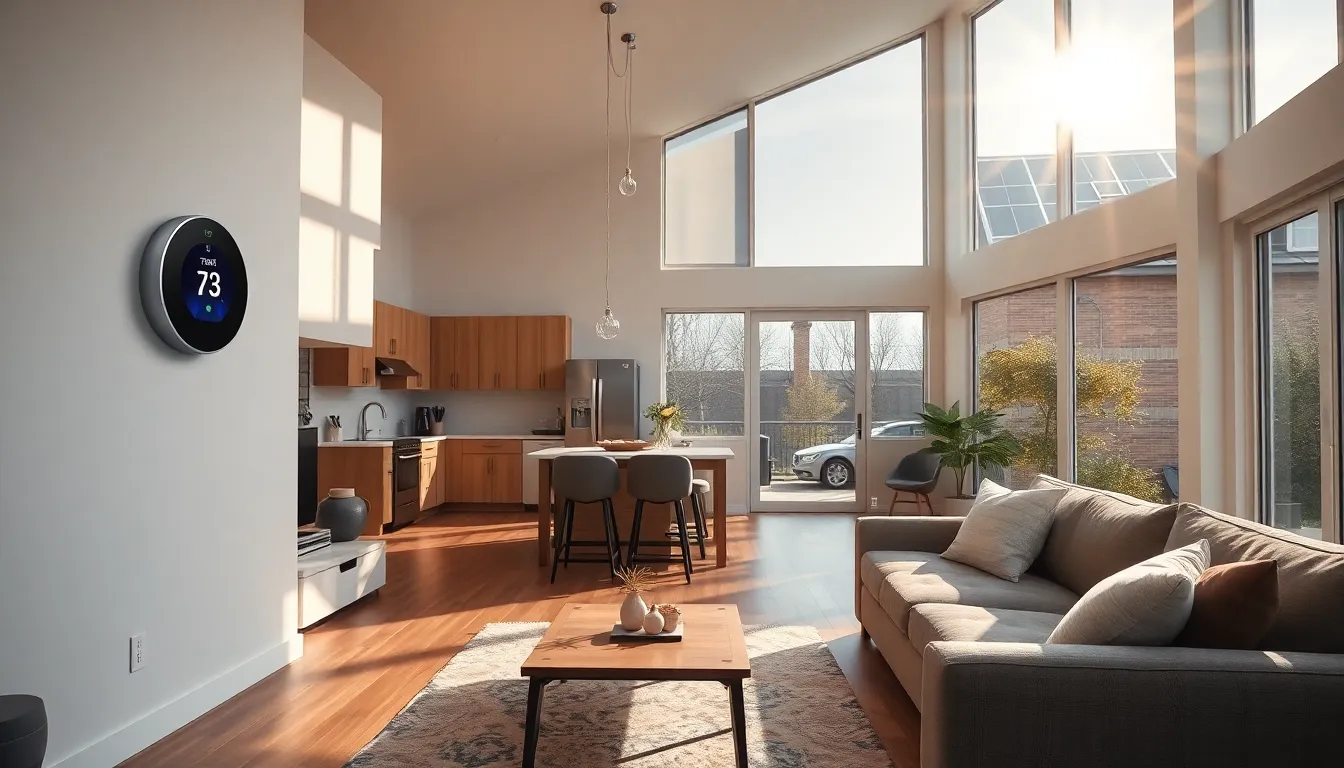Table of Contents
ToggleIn today’s world, where environmental concerns are at the forefront, green home automation is becoming a game changer. This innovative approach combines technology with sustainability, allowing homeowners to reduce their carbon footprint while enjoying modern conveniences. Imagine controlling your lights, heating, and appliances from your smartphone, all while making choices that benefit the planet.
Green home automation isn’t just about convenience; it’s about creating a more sustainable lifestyle. By integrating energy-efficient devices and smart systems, homeowners can save money on utility bills and contribute to a healthier environment. As technology evolves, the possibilities for eco-friendly living continue to expand, making it easier than ever to embrace a greener future.
Overview of Green Home Automation
Green home automation encompasses the integration of technology in residential settings to optimize energy efficiency and promote sustainability. This innovative solution combines smart devices and energy management systems that allow homeowners to monitor and control various aspects of their energy consumption seamlessly.
- Energy Management Systems: Energy management systems facilitate real-time tracking of energy use, enabling homeowners to identify patterns in consumption and adapt accordingly. These systems often work in conjunction with smart meters that provide detailed insights into usage.
- Smart Thermostats: Smart thermostats adjust heating and cooling based on homeowner preferences and occupancy patterns. They contribute to energy savings by ensuring the HVAC system operates only when necessary.
- Smart Lighting: Smart lighting systems allow users to automate lighting schedules, ensuring lights operate only when needed. This technology often includes motion sensors and dimming capabilities to enhance efficiency.
- Energy-Efficient Appliances: Green home automation commonly incorporates energy-efficient appliances that use less electricity and water than traditional models. These appliances are often designed to work seamlessly with home automation systems.
- Renewable Energy Integration: Many green automation solutions integrate renewable energy sources, such as solar panels. This integration enables homeowners to generate their own power, further reducing their reliance on fossil fuels and lowering utility costs.
- Home Energy Storage: Energy storage systems, such as batteries, store excess energy generated from renewable sources. These systems provide backup power during outages and maximize the use of renewable energy.
By embracing green home automation, homeowners not only reduce their carbon footprint but also enjoy long-term financial savings. Enhanced control over energy consumption contributes to a more sustainable lifestyle and promotes a healthier planet.
Benefits of Green Home Automation

Green home automation delivers numerous advantages that enhance both energy management and environmental sustainability.
Energy Efficiency
Energy efficiency stands as a primary benefit of green home automation. Smart devices optimize energy consumption by monitoring usage patterns and adjusting settings accordingly. For instance, smart thermostats automatically adjust temperature based on occupancy, leading to significant savings in heating and cooling costs. Energy management systems provide real-time data, allowing homeowners to identify energy waste and make informed decisions. According to the U.S. Department of Energy, implementing smart home technology can reduce energy bills by 10-30%.
Environmental Impact
Green home automation significantly reduces environmental impact. By integrating renewable energy sources such as solar panels, homeowners can decrease reliance on fossil fuels. Many systems include features that manage excess energy production, enabling homeowners to feed surplus energy back into the grid. Additionally, energy-efficient appliances consume less power, which lowers greenhouse gas emissions. The Environmental Protection Agency states that energy-efficient homes produce fewer pollutants, contributing to cleaner air and a healthier ecosystem.
Key Technologies in Green Home Automation
Green home automation relies on various technologies that enhance energy efficiency and reduce environmental impact. These technologies enable homeowners to optimize energy usage seamlessly.
Smart Thermostats
Smart thermostats play a crucial role in green home automation by managing heating and cooling systems efficiently. These devices learn user preferences and adjust settings automatically based on occupancy. For example, when no one is home, smart thermostats can lower heating or cooling, resulting in energy savings of up to 20%. Additionally, many smart thermostats offer remote access, allowing homeowners to control their home climates from anywhere. Features like scheduling and geofencing further enhance energy efficiency by ensuring systems operate only when needed.
Energy Monitoring Systems
Energy monitoring systems provide real-time insights into electricity consumption, empowering homeowners to manage energy use effectively. By installing smart energy monitors, users gain visibility into energy consumption patterns, identifying high usage periods or energy-hungry devices. This data enables informed decisions to reduce waste and optimize appliances’ use. According to the U.S. Department of Energy, homeowners can reduce their energy consumption by up to 15% through better awareness and management facilitated by monitoring systems. Many of these systems integrate with home automation hubs, allowing for automated responses that reduce energy consumption during peak times.
Implementing Green Home Automation
Implementing green home automation involves a series of strategic steps and selecting appropriate products to maximize energy efficiency in residential settings.
Steps to Get Started
- Assess the Home: Evaluate energy use patterns to identify areas for improvement. Focus on energy consumption from heating, cooling, lighting, and appliance use.
- Set Goals: Determine specific energy-saving objectives. Goals may include reducing energy bills by a certain percentage or achieving a specific carbon footprint reduction.
- Research Solutions: Investigate available smart technologies. Resources can include energy management systems, smart thermostats, smart lighting, and energy-efficient appliances.
- Create an Implementation Plan: Develop a timeline for installing systems and making upgrades. Prioritize projects based on budget and energy-use impact.
- Install and Configure Technology: Set up devices according to manufacturer instructions. Integration with existing systems enhances the overall effectiveness of green home automation.
- Monitor and Optimize: Regularly review energy performance data. Adjust settings and processes based on changing energy needs and consumption patterns.
Choosing the Right Products
- Energy Management Systems: Select systems that provide real-time energy usage data. Look for features like automated alerts, consumption analytics, and easy integration with other devices.
- Smart Thermostats: Choose thermostats that learn user behavior and adapt heating and cooling accordingly. Products with remote access and scheduling capabilities enhance convenience and efficiency.
- Smart Lighting Systems: Opt for LED bulbs that offer smart capabilities, including dimming and scheduling. Automated lighting reduces energy use and enhances home security when used effectively.
- Energy-Efficient Appliances: Look for appliances with ENERGY STAR ratings. These products consume less energy and resources while maintaining performance.
- Renewable Energy Solutions: Consider solar panels or wind turbines as supplementary energy sources. These options contribute to overall energy independence and reduced utility costs.
- Home Energy Storage Systems: Invest in energy storage solutions to maximize the use of renewable energy. Battery systems store excess solar power for later use, enhancing energy efficiency.
Future Trends in Green Home Automation
Emerging trends in green home automation focus on enhancing energy efficiency and promoting sustainability. These technologies aim to integrate seamlessly into daily life while reducing environmental impact.
Increased Integration of IoT Devices
IoT devices enhance connectivity and communication between smart appliances, energy management systems, and renewable energy sources. The interconnectedness allows homeowners to control multiple systems through a single platform, providing a streamlined and efficient approach to energy use.
Advanced AI Capabilities
AI plays a vital role in optimizing energy consumption. Smart devices equipped with AI can learn user behaviors, adapt settings in real-time, and predict energy needs based on historical data. This capability can lead to energy efficiency improvements of up to 30%.
Enhanced Renewable Energy Solutions
Innovative renewable energy solutions are gaining traction. Technologies such as integrated solar panels and wind turbines can now work in tandem with home automation systems. These systems allow homeowners to maximize energy generation and reduce reliance on-grid electricity.
Smart Energy Management Systems
Next-generation energy management systems provide more comprehensive insights into energy usage. Real-time dashboards allow users to monitor consumption patterns and receive actionable recommendations. Homeowners can adjust their behavior to achieve energy savings of 15% or more.
Sustainable Building Materials
The use of sustainable materials in home automation solutions is on the rise. Products made from recycled or eco-friendly materials contribute to a smaller carbon footprint during the construction and automation process, supporting overall green building practices.
Increased Focus on Indoor Air Quality
Smart technologies are increasingly addressing indoor air quality (IAQ) through automated ventilation and air purification systems. These systems monitor pollutants and optimize airflow, creating healthier living environments while reducing energy consumption.
Decentralized Energy Generation
Decentralized energy systems are gaining popularity, allowing homeowners to generate and store their energy independently. Technologies like home batteries and microgrids provide resilience and sustainability, empowering homeowners to manage their energy production effectively.
Emphasis on User Engagement and Education
User engagement strategies are evolving to educate homeowners about the benefits of green home automation. Enhanced interfaces and educational tools encourage active participation in energy management, leading to better decision-making and long-term energy savings.
Regulation and Incentive Alignment
Future trends will likely include stronger regulations and incentives to promote green technologies. As governments implement policies to encourage energy efficiency and sustainability, homeowners may benefit from financial support for adopting green home automation solutions.
Green home automation represents a pivotal shift towards sustainable living. By integrating smart technologies into everyday life, homeowners can significantly reduce energy consumption and lower their utility costs. This approach not only enhances convenience but also actively contributes to a healthier environment.
As advancements in technology continue to evolve, the potential for energy efficiency and sustainability will only grow. Homeowners who embrace these innovations are not just investing in their homes but also in a greener future. The commitment to reducing carbon footprints and promoting eco-friendly practices is more crucial than ever. Adopting green home automation is a step toward a sustainable lifestyle that benefits both individuals and the planet.









